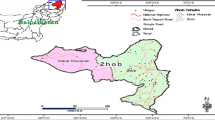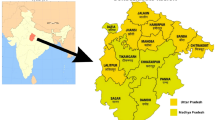Abstract
Crop production in the tropics is subject to considerable climate variability caused by the El Niño-Southern Oscillation (ENSO) phenomenon that is likely to become even more pronounced during the twenty-first century. Little is known about the impact of ENSO-related drought on crop yields and food security, especially at the household level. This paper seeks to contribute to closing this knowledge gap with a case study from Central Sulawesi, Indonesia. Its main objective is to measure household resilience towards drought periods and to identify its influencing factors to deduce policy implications. Using indicators for consumption expenditures, we construct an index measuring household drought resilience; we then apply an asset-based livelihood framework to identify its determinants. Most of the drought-affected farm households are forced to substantially reduce expenditures for food and other basic necessities. Households’ drought resilience is strengthened by the possession of liquid assets, access to credit, and the level of technical efficiency in agricultural production. The results suggest a number of policy recommendations, namely improvement of the farmers’ access to ENSO forecasts, the provision of credit and savings products to facilitate consumption smoothing, and the intensification of agricultural extension in view of low levels of productivity found in agricultural production.
Similar content being viewed by others
References
Amien I, Rejekiningrum P, Pramudia A, Susanti E (1996) Effects of interannual climate variability and climate change on rice yields in Java, Indonesia. Water Air Soil Pollut 92:29–39
Bang K, Sitango K (2003) Indigenous drought coping strategies and risk management in Papua New Guinea, CGPRT Monograph 43, Centre for research and development of coarse grains, pulses, roots and tuber crops in the humid tropics of Asia and the Pacific, Bogor, Indonesia, pp 147–163
Battese GE (1997) A note on the estimation of Cobb–Douglas production functions when some explanatory variables have zero values. J Agric Econ 48(2):250–252
Battese GE, Coelli TJ (1995) A model for technical inefficiency effects in a stochastic frontier production function for panel data. Empir Econ 20:325–332
Datt G, Hoogeveen H (2003) El Niño or El Peso? Crisis, poverty and income distribution in the Philippines. World Dev 31(7):1103–1124
Devereux S (2003) Conceptualising destitution, IDS Working Paper No. 216. Institute of Development Studies, University of Sussex, Brighton, UK
Diagne A, Zeller M, Sharma M (2000) Empirical measurements of households’ access to credit and credit constraints in developing countries: Methodological issues and evidence, Discussion Paper No. 90, Food Consumption and Nutrition Divison, International Food Policy Research Institute (IFPRI), Washington, DC
Ellis F (1998) Household strategies and rural livelihood diversification. J Dev Stud 35(1):1–38
Fafchamps M, Udry C, Czukas K (1998) Drought and saving in West Africa: Are livestock a buffer stock? J Dev Econ 55:273–305
Falcon WP, Naylor RL, Smith WL, Burke MB, McCullough EB (2004) Using climate models to improve Indonesian food security. Bull Indones Econ Stud 40(3):357–379
Farrell MJ (1957) The measurement of productive efficiency. J R Stat Soc 120:253–290
Harger JRE (1995) ENSO variations and drought occurrence in Indonesia and the Philippines. Atmos Environ 29:1943–1956
Keil A (2004) The socio-economic impact of ENSO-related drought on farm households in Central Sulawesi, Indonesia, Shaker, Aachen, Germany
McCarthy JJ, Canziani, OF, Leary, NA, Dokken DJ, White KS (Eds.): 2001, Climate change 2001: Impacts, adaptation, and vulnerability. Contribution of Working Group II to the Third Assessment Report of the Intergovernmental Panel on Climate Change, Cambridge University Press, Cambridge, UK
Monsalud C, Montesur G, Limosinero L (2003) Coping strategies against El Niño: The case of selected communities in Talugtug, Nueva Ecija, the Philippines, CGPRT Monograph 43, Centre for research and development of coarse grains, pulses, roots and tuber crops in the humid tropics of Asia and the Pacific, Bogor, Indonesia, pp 171–179
Morduch J (1995) Income smoothing and consumption smoothing. J Econ Perspect 9(3):103–114
Naylor RL, Falcon WP, Rochberg D, Wada N (2001) Using El Niño/Southern Oscillation climate data to predict rice production in Indonesia. Clim Change 50:255–265
NOAA: (2005) National Oceanic and Atmospheric Administration – Climate Prediction Center: http://www.cpc.ncep.noaa.gov, 25.07.2006
Quinn WH, Zopf DO, Short, KS, Kuo Yang RTW (1978) Historical trends and statistics of the Southern Oscillation, El Niño, and Indonesian droughts. Fish Bull 76:663–678
Roumasset JA (1976) Rice and risk: decision making among low-income farmers. North-Holland, Amsterdam, The Netherlands
Salafsky N (1994) Drought in the rainforest: Effects of the 1991 El Nino-Southern Oscillation event on a rural economy in West Kalimantan, Indonesia. Clim Change 27:373–396
Scoones I (1998), Sustainable rural livelihoods: A Framework for Analysis, IDS Working Paper No. 72, Institute of Development Studies, University of Sussex, Brighton, UK
Sen A (1981) Poverty and famines. An essay on entitlement and deprivation. Clarendon, Oxford, UK
Siegel PB, Alwang J (1999) An asset-based approach to social risk management: a conceptual framework. Social Protection Discussion Paper No. 9926, The World Bank, Washington, DC
Stevens JP (2002) Applied multivariate statistics for the social sciences, 4th edn. Erlbaum, Mahwah, USA
Tobin J (1958) Estimation of relationships for limited dependent variables. Econometrica 26:24–36
Webb P, Harinarayan A (1999) A measure of uncertainty: The nature of vulnerability and its relationship to malnutrition. Disasters 23(4):292–305
White H (1980) A heteroskedasticity-consistent covariance matrix estimator and a direct test for heteroskedasticity. Econometrica 48(4):817–838
WHO/FAO (1973) Energy and protein requirements. World Health Organisation Technical Report Series No. 522, World Health Organisation (WHO), Geneva, Switzerland
WWF (1981) Lore Lindu National Park Management Plan 1981–1986. World Wildlife Fund report for the Directorate of Nature Conservation, Bogor, Indonesia
Zeller M, Schrieder G, von Braun J, Heidhues F (1997) Rural finance for food security for the poor: implications for policy and research. International Food Policy Research Institute (IFPRI), Washington, DC
Zhao Y, Wang C, Wang S, Tibig LV (2005) Impacts of present and future climate variability on agriculture and forestry in the humid and sub-humid tropics. Clim Change 70:73–116
Author information
Authors and Affiliations
Corresponding author
Rights and permissions
About this article
Cite this article
Keil, A., Zeller, M., Wida, A. et al. What determines farmers’ resilience towards ENSO-related drought? An empirical assessment in Central Sulawesi, Indonesia. Climatic Change 86, 291–307 (2008). https://doi.org/10.1007/s10584-007-9326-4
Received:
Accepted:
Published:
Issue Date:
DOI: https://doi.org/10.1007/s10584-007-9326-4




